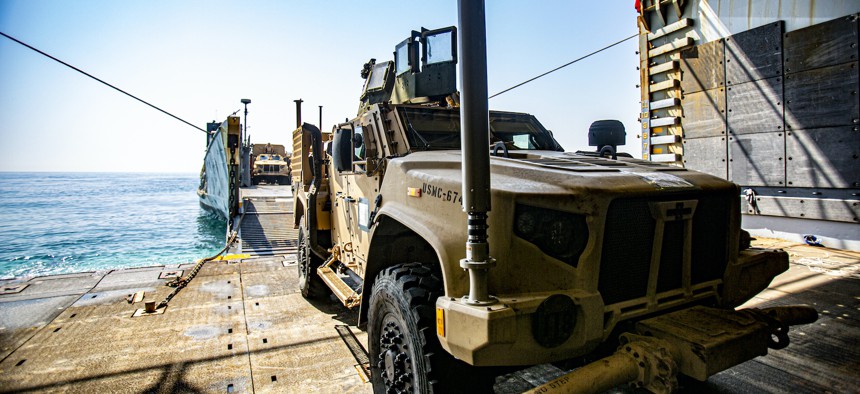
A joint light tactical vehicle attached to the 24th Marine Expeditionary Unit (MEU) is transferred from dock landing ship USS Carter Hall (LSD 50) to Landing Craft Utility 1661 during vehicle and equipment loading operations in the Arabian Gulf, July 16, 2021. U.S. Marine Corps / 1st Lt. Mark Andries
Less Efficient, More Resilient: The Marine Corps’ Plan for Modernizing its Logistics Operations
Installations and Logistics 2030 document is latest release in the service’s ongoing Force Design efforts.
The Marine Corps on Thursday revealed its plan for overhauling its logistics for an environment that is “contested across all domains and at global scale every day,” noting that its concerns about the battlefield of the future have been validated by the war in Ukraine.
“We have witnessed a numerically superior force struggle to sustain itself and protect supply routes against persistent attack and disruption. We take this as a warning in our own campaign of learning,” Lt. Gen. Edward Banta, deputy commandant for installations and logistics, said in the “Installations and Logistics 2030” plan. “Our objective is certain: Sustain the force in the contested operating environment.”
Doing so will require taking a hard look at existing capabilities and infrastructure to determine if they are up for the job, creating a more web-like approach to logistics than the current streamlined model, and finding creative solutions to a wide range of modern threats, according to the document. Those solutions include a global positioning network and a range of autonomous systems.
The integrated global positioning network is “a combination of both afloat and ashore platforms that enables campaigning,” Col. Matthew Mulvey, futures branch head for logistics vision and strategy, told reporters before the document’s release. “That’s steady-state operations that Marines will do from day to day. And by having that forward-positioned equipment and capabilities inside the first island chain and in the Indo-Pacific, we can transition much more efficiently from campaigning to a conflict scenario if we need that.”
Some of the autonomous systems are already in the works, including a Tactical Resupply Unmanned Aerial System—TRUAS—that will be fielded to Marine combat logistics battalions within the next year, said Lt. Col. Kieran O’Neil, also from futures branch - logistics vision and strategy.
The service’s installations will help the effort by experimenting with some of the autonomous systems and vehicles on the bases before they turn them over to a unit for use in the field, said Col. Dane Salm, assistant chief of staff for operations and plans for Marine Corps Installations Command.
Mulvey underscored that these autonomous systems will not just be flying. “We’re looking at ground transportation, autonomous vehicles on the sea, and even under the sea, trying to get multiple different options to close the distance from the requirements and where that requirement is going to be sourced,” he said.
The plan also highlights the need for more resilient bases, with the understanding that those installations could come under attack—by drone or by humans—in the future.
“We are expanding alternative energy options aboard our bases including solar and biomass turbines. We are also exploring defensive capabilities to counter unmanned aerial systems, and the ability to rapidly repair runways and even facilities with construction 3D printing,” Banta said in prepared remarks.
Some of the concepts and changes in the plan are already underway, Col. Aaron Angell, executive assistant for installations and logistics, told reporters.
“A lot of this is actually already being seen around the force… We have made some adjustments to all of our units,” including 3rd Littoral Logistics Battalion in Hawaii, Angell said. “They have adjusted to be a multifunctional capability. So really they have the ability to do transportation as well as medical capability, supply, maintenance, general engineering, and even some other limited services like contracting.”
Banta said the retooling of installations and logistics is necessary because the Marine Corps has been “spoiled by two decades of conducting strategic and operational logistics in a permissive environment, where we had general freedom of movement across the globe, and without threat to our defense industrial base and our reliance on commercial partners for global distribution and mobility. Today we face cyber threats to our energy and transportation networks, small [unmanned aerial systems] threats in the skies above our installations, and even manufacturing competition down to the small business owner who builds the ball bearings, nuts and bolts, and innovative components for our smart systems.”
Now the Marines must “adapt from streamlined efficient supply chains that can be vulnerable with just one disruption or break of a link in that chain to sustainment webs that are more resilient across a theater of operations,” he said.
NEXT STORY: One Year On, Why Putin Has Already Lost the War




